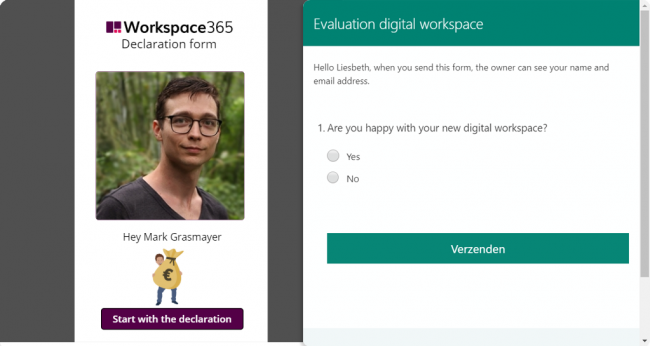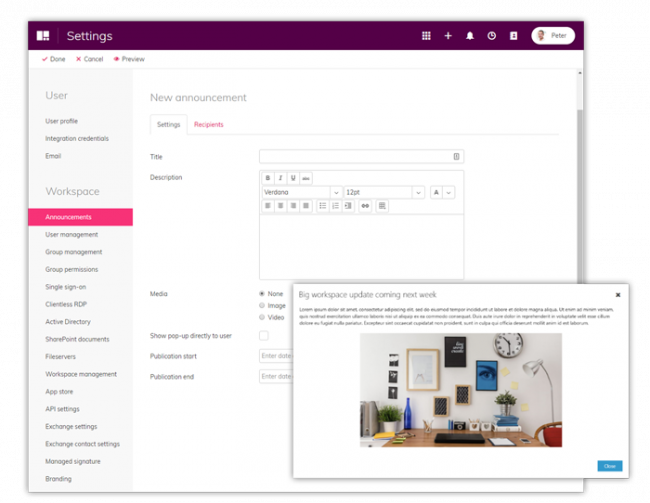
4 ways Microsoft 365 helps HR professionals
In recent times, we've seen how more and more companies have started to use Microsoft 365 as part of their digital workplace solutions. Also known as Office 365, this cloud-based platform features a wide variety of essential online workspace tools including Outlook, Office (Word, Excel, PowerPoint), SharePoint, Microsoft Teams, Yammer, the Power Platform, and more.
Microsoft 365 offers users a wide variety of benefits; from driving efficiency to encouraging collaboration and enabling them to carry out a full-on digital transformation. It has also been of vital importance in terms of facilitating remote working during the recent global pandemic.
Book a demo
A diverse and powerful platform, Microsoft 365 can have a transformational impact on almost every role within an organisation. It has proven itself to be particularly useful for support functions such as IT, Marketing and Human Resources (HR).
In fact, the increased implementation of Microsoft 365 is great news for this last group of professionals in particular as it allows for higher efficiency across core HR processes whilst also supporting objectives such as improving employee experience.
In the following post, we'll be taking a deep dive into just some of the wide range of features that Microsoft 365 has to offer in order to give you a greater understanding of how the platform benefits HR functions.
How does Microsoft 365 help HR professionals?
At a macro level, Microsoft 365 supports HR professionals and teams across four major areas:
1. Improving Employee Experience
There's an increased awareness nowadays of the importance of what is known as Employee Experience - the overall experience that a person has with their company across various touchpoints. Evidence has shown us how this can have a considerable impact on things such as talent retention and the ability to attract new people to an organisation.
An evaluation of Employee Experience involves taking a holistic and strategic look at the Employee Value Proposition (EVP) on offer throughout a person's time at a company. This includes having a close look at the employee workspace and learning about people's everyday experiences with technology.
In this sense, Microsoft 365 can play a successful role in terms of enhancing employees' day-to-day experience of the digital workspace. Important processes like onboarding or learning & development can be greatly improved, and the platform can also help nurture a healthier organisational culture that will inevitably have a positive impact on employee experience.
2. Driving productivity
Encouraging more efficient practices, services and support should be a constant priority for any HR department. With this in mind, Microsoft 365 can play a significant role in making this happen by transforming and in some cases revolutionising a number of core HR processes. It allows you to do so in the following ways:
- Driving the standardisation of HR practices across larger organisations by ensuring everybody has access to the right information and documents.
- Taking the pressure off of busy HR support teams by digitising manual or email-based processes like booking annual leave, thereby improving productivity and providing tools and information that help drive self-service.
- Using automation to streamline HR transactions and provide information for employees, utilising tools such as chatbots.
- Using Power BI to provide reporting dashboards for people and workforce analytics.
3. Supporting smart working
Giving employees a choice of where they work – be it from home or from another location, has always been an attractive option for people. Virtual workspace platforms such as Microsoft 365 have been driving the evolution of the hybrid workspace for a number of years now, making the prospect of smart working a reality for more and more people around the world. However, it was the pandemic in 2020 that truly provided the change moment, exponentially ramping up demand for a high-quality virtual workspace that allows people to work flexibly and remotely. The smart working revolution has been profound and will continue to be part of our lives in a post-pandemic world.
4. Promoting collaboration across the HR team
Microsoft 365 contains several tools such as Yammer, Microsoft Teams and SharePoint that allow HR teams to communicate, collaborate on key projects, coordinate their activities and access documents. In large organisations that are spread across multiple locations, these tools help bring HR functions much closer together, utilising the virtual workspace to its full potential by making it possible to work as part of a far more compact team.
How does a platform like Workspace 365 support HR professionals?
One frequent issue with Microsoft 365 is that it can often be tricky for people who are trying to get to grips with the massive variety of tools and features on offer. The sheer volume of these, many of which facilitate new ways of working, can sometimes be overwhelming, and governance, coordination, and change management are needed to get the most out of the platform.
For this reason, many organisations choose to maximise the return on investment with Microsoft 365 by purchasing a digital workspace product that sits alongside it, delivering an overall experience that's more tailored to the specific needs of their employees. A platform like WorkSpace 365 can be hugely beneficial to HR teams as it allows them to build the exact kind of digital employee experience they want without having to sacrifice any of the benefits of Microsoft 365.
Let’s look at some of the ways that platforms such as Workspace 365 can help HR teams carry out their day-to-day tasks.
1. Putting everything you need into one place
One of the most common complaints that people have about their online workspace is that it is far too fragmented. Employees often have to work with several different applications depending on the task, information is sometimes hidden in silos and consequently, a huge amount of time is wasted.
Workspace 365 allows you to create one single, all-encompassing, and secure digital workplace environment where employees use Single Sign-On to gain access to several different apps, find information and carry out tasks. People no longer have to deal with the frustration of having to jump between multiple platforms to find what they need to get the job done. This contributes to a better overall employee experience as people recognise that the virtual workspace is working for them, reducing information overload and increasing their overall level of productivity.
2. Supporting adoption of Microsoft 365 tools that drive efficiency
Workspace 365 supports the adoption of tools and elements of a SharePoint workspace that allow you to effectively streamline HR processes and encourage employee self-service. By highlighting these tools, providing easy access via Single Sign-On, and sharing “how to” resources, you can build your department around the digital workplace solutions of your choice.
Within the workspace, you can also integrate Microsoft Forms or Power Apps to research your employee satisfaction rate, and allow them to request annual leave or submit claims.

3. Providing easy access to key documents and policies
Workspace 365 provides easy access to key files and information while also encouraging employee self-service and the standardisation of HR practices. This eliminates confusion, removes the possibility of coming across out-of-date documents, and greatly reduces the time that HR workers spend dealing with basic and routine questions.
You can create a tile(s) on the digital workspace that displays important documents such as employee handbooks, job descriptions, performance appraisal forms, salary scales, information about working conditions, and much more.
4. Using content targeting to ensure different roles and locations have access to the right HR information
Using a virtual workspace platform like Workspace 365 allows you to centralise all communication and information whilst also ensuring that the content delivered is relevant to the respective roles, locations and divisions that make up your organisation. Content targeting based on Active Directory groups means that managers with specific HR processes to carry out, employees in different offices who use separate HR systems, and groups working in multiple languages will only see the information that is relevant to them.
5. Providing HR updates and notifications together in one place
Employees are often bombarded with emails from HR with reminders, requests, approvals and updates. Aside from being overwhelming, this means that important information can get easily lost in the sea of general inbox noise or create bottlenecks with approval processes.
With Workspace 365, employees and managers can make use of the Announcement Centre to bring all HR updates and notifications together into one convenient place, allowing them to carry out tasks with increased speed and productivity.

6. Using Micro Apps to encourage HR self-service
Workspace 365 can help you build custom Micro Apps that are excellent in terms of promoting self-service for key HR tasks such as booking annual leave, logging a support ticket, organising performance reviews, reviewing mandatory training and much more.
By integrating your HR systems, you can create Micro Apps that help employees get things done quicker, without actually having to access the HR systems themselves.
7. Employing chatbots to reduce the workload of busy HR support staff
Chatbots use AI and natural language processing to allow employees to find information and complete transactions with a more natural style of conversation.
The Workspace 365 platform can incorporate an HR support chatbot, taking a great deal of pressure off of busy HR helpdesks. It does so by automating simple tasks such as logging a ticket, sending people to FAQs, and providing other information relevant to their questions.
8. Supporting remote working
Remote working is going to play an increasingly significant role going forward in the post-pandemic world. Workspace 365 presents a secure hybrid workspace environment that can be accessed from absolutely anywhere and has no problem supporting all kinds of scaled-up remote working capabilities. The workspace automatically adapts to each employee's individual role, device, location, operating system, and browser.
9. Employee onboarding
A key process for HR professionals is employee onboarding. When done well, this has been shown to effectively reduce employee turnover. It also makes new starters feel more welcome and drives efficiency by getting them up to speed with how things work at your company.
Workspace 365 helps bring all the information, checklists, and forms that new hires need into one place. It is even possible to give them access to the platform before their first day to make sure they hit the ground running.
10. Providing resources for HR professionals
Workspace 365 brings HR employees closer together by providing them with a focused virtual workspace where they have access to all the resources, systems and documents that they need to get the job done. It allows global HR teams in particular to stay more connected, offering them the possibility to collaborate and communicate effectively across multiple locations.
Schedule a free Workspace 365 trial
As many HR professionals are finding out already, integrating Microsoft 365 and Workspace 365 into a company's digital workspace solutions can have a transformative impact in terms of employees' overall experience.
More and more organisations are enjoying the benefits that these platforms have to offer, allowing them to boost overall productivity and achieve all kinds of strategic and operational objectives in the virtual workspace.
However, you shouldn't just take our word for it. Remember, the best way to experience Workspace 365 is to try it for yourself.